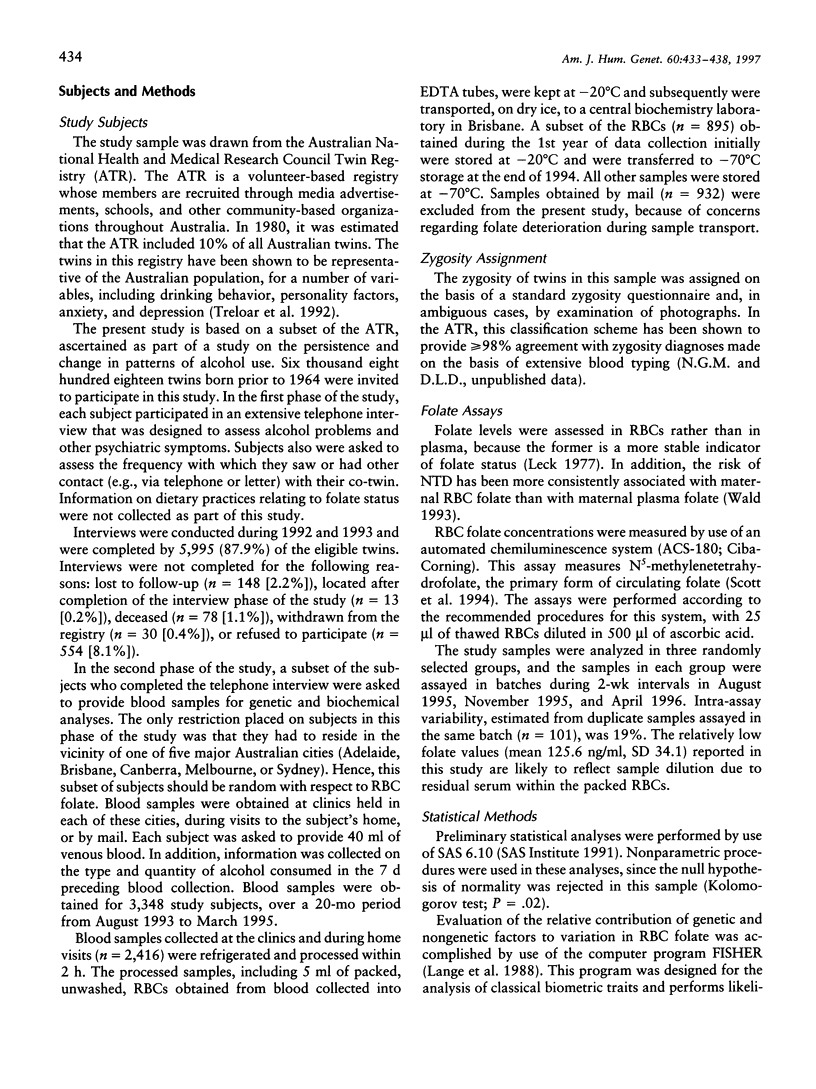Abstract
Recent studies have implicated folic acid as an important determinant of normal human growth, development, and function. Insufficient folate levels appear to be a risk factor for neural tube defects (NTD), as well as for several chronic diseases of adulthood. However, relatively little is known about the factors that influence folate status in the general population. To estimate the relative contribution of genetic and nongenetic factors to variation in folate, we have evaluated red blood cell (RBC) folate levels in 440 pairs of MZ twins and in 331 pairs of DZ twins. The data were best described by a model in which 46% of the variance in RBC folate was attributable to additive genetic effects, 16% of the variance was due to measured phenotypic covariates, and 38% of the variance was due to random environmental effects. Moreover, the correlations for RBC folate in MZ co-twins (r = .46) and in repeat measures from the same individual (r = .51) were very similar, indicating that virtually all repeatable variation in RBC folate is attributable to genetic factors. On the basis of these results, it would seem reasonable to initiate a search for the specific genes that influence RBC folate levels in the general population. Such genes ultimately may be used to identify individuals at increased risk for NTD and other folate-related diseases.
Full text
PDF





Selected References
These references are in PubMed. This may not be the complete list of references from this article.
- Aalen O. O. Modelling the influence of risk factors on familial aggregation of disease. Biometrics. 1991 Sep;47(3):933–945. [PubMed] [Google Scholar]
- Boushey C. J., Beresford S. A., Omenn G. S., Motulsky A. G. A quantitative assessment of plasma homocysteine as a risk factor for vascular disease. Probable benefits of increasing folic acid intakes. JAMA. 1995 Oct 4;274(13):1049–1057. doi: 10.1001/jama.1995.03530130055028. [DOI] [PubMed] [Google Scholar]
- Cowchock S., Ainbender E., Prescott G., Crandall B., Lau L., Heller R., Muir W. A., Kloza E., Feigelson M., Mennuti M. The recurrence risk for neural tube defects in the United States: a collaborative study. Am J Med Genet. 1980;5(3):309–314. doi: 10.1002/ajmg.1320050314. [DOI] [PubMed] [Google Scholar]
- Cragan J. D., Roberts H. E., Edmonds L. D., Khoury M. J., Kirby R. S., Shaw G. M., Velie E. M., Merz R. D., Forrester M. B., Williamson R. A. Surveillance for anencephaly and spina bifida and the impact of prenatal diagnosis--United States, 1985-1994. MMWR CDC Surveill Summ. 1995 Aug 25;44(4):1–13. [PubMed] [Google Scholar]
- Czeizel A. E., Dudás I. Prevention of the first occurrence of neural-tube defects by periconceptional vitamin supplementation. N Engl J Med. 1992 Dec 24;327(26):1832–1835. doi: 10.1056/NEJM199212243272602. [DOI] [PubMed] [Google Scholar]
- Czeizel A. E. Reduction of urinary tract and cardiovascular defects by periconceptional multivitamin supplementation. Am J Med Genet. 1996 Mar 15;62(2):179–183. doi: 10.1002/(SICI)1096-8628(19960315)62:2<179::AID-AJMG12>3.0.CO;2-L. [DOI] [PubMed] [Google Scholar]
- Daly L. E., Kirke P. N., Molloy A., Weir D. G., Scott J. M. Folate levels and neural tube defects. Implications for prevention. JAMA. 1995 Dec 6;274(21):1698–1702. doi: 10.1001/jama.1995.03530210052030. [DOI] [PubMed] [Google Scholar]
- Davis R. E. Clinical chemistry of folic acid. Adv Clin Chem. 1986;25:233–294. doi: 10.1016/s0065-2423(08)60127-4. [DOI] [PubMed] [Google Scholar]
- Hopper J. L., Carlin J. B. Familial aggregation of a disease consequent upon correlation between relatives in a risk factor measured on a continuous scale. Am J Epidemiol. 1992 Nov 1;136(9):1138–1147. doi: 10.1093/oxfordjournals.aje.a116580. [DOI] [PubMed] [Google Scholar]
- Lange K., Weeks D., Boehnke M. Programs for Pedigree Analysis: MENDEL, FISHER, and dGENE. Genet Epidemiol. 1988;5(6):471–472. doi: 10.1002/gepi.1370050611. [DOI] [PubMed] [Google Scholar]
- Leck I. Folates and the fetus. Lancet. 1977 May 21;1(8021):1099–1100. doi: 10.1016/s0140-6736(77)92349-2. [DOI] [PubMed] [Google Scholar]
- Li D. K., Daling J. R., Mueller B. A., Hickok D. E., Fantel A. G., Weiss N. S. Periconceptional multivitamin use in relation to the risk of congenital urinary tract anomalies. Epidemiology. 1995 May;6(3):212–218. doi: 10.1097/00001648-199505000-00004. [DOI] [PubMed] [Google Scholar]
- Shaw G. M., Lammer E. J., Wasserman C. R., O'Malley C. D., Tolarova M. M. Risks of orofacial clefts in children born to women using multivitamins containing folic acid periconceptionally. Lancet. 1995 Aug 12;346(8972):393–396. doi: 10.1016/s0140-6736(95)92778-6. [DOI] [PubMed] [Google Scholar]
- Treloar S. A., Martin N. G., Dennerstein L., Raphael B., Heath A. C. Pathways to hysterectomy: insights from longitudinal twin research. Am J Obstet Gynecol. 1992 Jul;167(1):82–88. doi: 10.1016/s0002-9378(11)91632-9. [DOI] [PubMed] [Google Scholar]
- Wald N. Folic acid and the prevention of neural tube defects. Ann N Y Acad Sci. 1993 Mar 15;678:112–129. doi: 10.1111/j.1749-6632.1993.tb26114.x. [DOI] [PubMed] [Google Scholar]


